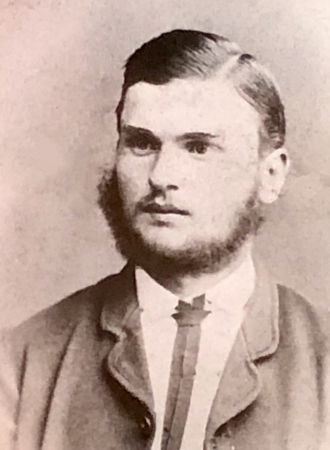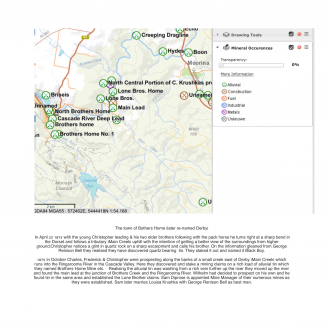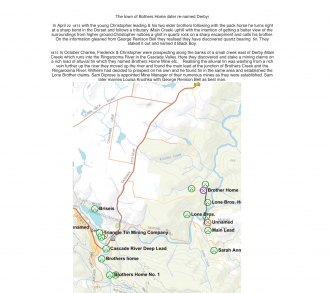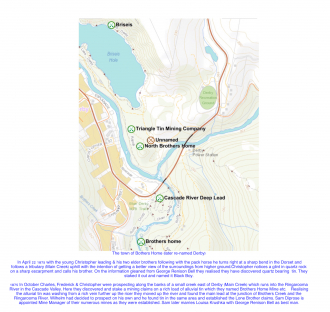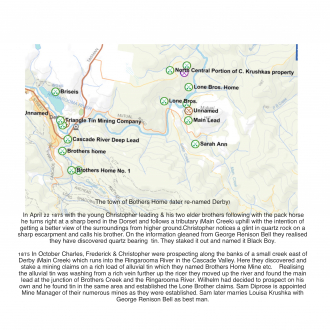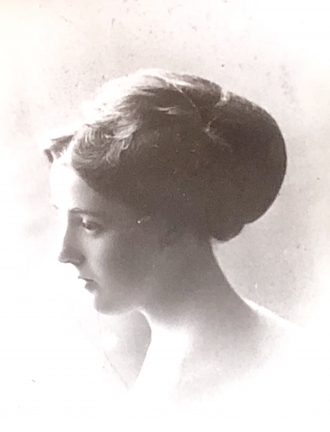Advertisement
Advertisement
Alan Curtis
About me:
I haven't shared any details about myself.
About my family:
I haven't shared details about my family.
Updated: July 19, 2023
Message Alan Curtis
Loading...one moment please


Recent Activity

Alan Curtis
followed a bio
Mar 04, 2020 3:27 PM

Alan Curtis
followed a bio
Mar 04, 2020 3:27 PM

Alan Curtis
updated a photo
Jun 21, 2019 11:19 PM
title, description
Christian Kruschke, A photo of Christian Kruschke
Christian Kruschke, A photo of Christian Kruschke

Alan Curtis
tagged a photo
Jun 21, 2019 11:19 PM

Alan Curtis
shared a photo
Jun 21, 2019 11:19 PM
Christian Kruschke Family History
A photo of Christian Kruschke
A photo of Christian Kruschke
Photos Added
Recent Comments
Alan hasn't made any comments yet
Alan's Followers
Logan Krushka
About me:I haven't shared any details about myself.
Adam Edwards
About me:I haven't shared any details about myself.
Favorites
Loading...one moment please


AncientFaces
This account is shared by Community Support (Kathy Pinna & Daniel Pinna & Lizzie Kunde) so we can quickly answer any questions you might have.
Please reach out and message us here if you have any questions, feedback, requests to merge biographies, or just want to say hi!
2020 marks 20 years since the inception of AncientFaces. We are the same team who began this community so long ago. Over the years it feels, at least to us, that our family has expanded to include so many. Thank you!
2020 marks 20 years since the inception of AncientFaces. We are the same team who began this community so long ago. Over the years it feels, at least to us, that our family has expanded to include so many. Thank you!

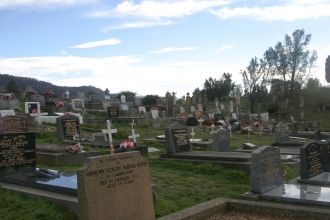
Miene was born at Luburnum Park early morning on the 25th April 1957 and in the afternoon. Cause of death unknown.
Miene is buried in an unmarked grave at Richmond, Tasmania,


Louisa Joanna (Krushka) Diprose was born in 1860 at Richmond, Tas to Johanna "Jane Louisa" Clocke Kruschke and Christian Kruschke, and has siblings Christopher Krushka, Fennit Kruschke, Wilhelm "William" Kruschke, Augusta Freder Kruschke Gill, Charles Matthew Kruschke, Frederick Kruschke, Wilhelmina Krushka, and Miene Wilhelm Krushka. Louisa Diprose married Samuel Frederick Oliver Diprose, and has children Roy Diprose, Ruby Gladys Diprose, Una Edeline Diprose, and Emy Diprose. Family, friend, or fan, this family history biography is for you to remember Louisa Joanna (Krushka) Diprose.

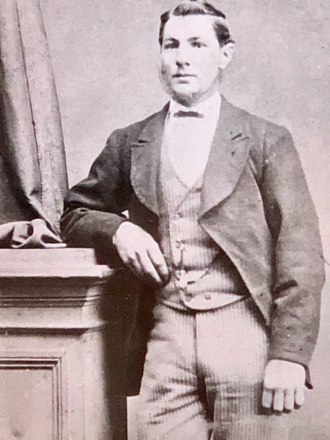
Re attached death Certificate:
Van Deimens Land have issued this certificate (birth date) based on Kushka surname issue date because of no previous family records
1875 With 1 pack horse Charles 24, Frederick 22 and Christopher 16 set out along the banks of the Dorset River prospecting. On April 22 1875 with the young Christopher leading & his two elder brothers following with the pack horse he turns right at a sharp bend in the Dorset and follows a tributary uphill with the intention of getting a better view of the surroundings from higher ground.Christopher notices a glint in quartz rock on a sharp escarpment and calls his brother. On the information gleaned from George Renison Bell they realised they have discovered quartz bearing tin. They staked it out and named it Black Boy
1875 In October Charles, Frederick & Christopher were prospecting along the banks of a small creek east of Derby (Main Creek) which runs into the Ringarooma River in the Cascade Valley. Here they discovered and stake a mining claims on a rich load of alluvial tin which they named Brothers Home Mine etc. Realising the alluvial tin was washing from a rich vein further up the river they moved up the river and found the main lead at the junction of Brothers Creek and the Ringarooma River. Wilhelm had decided to prospect on his own and he found tin in the same area and established the Lone Brother claims. Sam Diprose is appointed Mine Manager of their numerous mines as they were established. Sam later marries Louisa Krushka with George Renison Bell as best man.
When the Krushka brothers discovered the alluvial tin they contacted their now lifelong friend George Renison Bell (Little Bell) who along with other friends stake out further claims along the creek.
1876 The Krushka brother cut a cart track from the mine to the original town of Ringarooma on Ringarooma Bay (Boobyalla) as it was faster & cheaper to ship the ore to Launceston from there than out of Bridport. They build a bridge across the Ringarooma River for the track and name it Krushkas Bridge (renamed Moorina)
1876 Frederick purchases a large track of land in Upper Ringarooma stretching south to New River. He calls it Mineral Banks.
In the same period they purchase other parcels of land near the mine & at Upper Ringarooma.
Note:
1882 In January the Governor Sir George C Strahan in the town of Krushka with the intention of naming it Strahan. He stays in the largest house in town (North View) and after a night of merriment departs without proclaiming it Strahan.
The discovery of tin in and around the Cascade River Valley in the 1800's by George Renison Bell, the Krushka Brothers and others leads to the rapid development of farms & logging in the North East and the towns of Brothers Home (renamed Derby) Krushka Town (renamed Ringarooma) & Krushkas Bridge (renamed Moorina.
The original port town of Ringarooma at the mouth of the Ringarooma River was renamed Boobyalla. Mining, dredging, logging and land clearing along the length of the Ringarooma River created major siltting at it’s mouth resulting in the loss of the town and port.
Derby:
The area had been surveyed in 1855, but was not settled until 1874, Krushka brothers discovered a large lode of tin, and set up a mine (named The Brothers Mine) in the area, assuring the town's economic future. The town was originally known as Brother's Home until renamed Derby (believed to be after Edward Smith-Stanley, 14th Earl of Derby the Prime Minister of the United Kingdom).
Brother's Home Post Office opened on 1 August 1882 and was renamed Derby in 1885.
Derby reached its peak in the late 19th century, when its population reached over 3,000, and the Brothers Mine (renamed the Briseis Mine after the winner of the 1876 Melbourne Cup) was producing upwards of 120 tonnes of tin per month.
On 4 April 1929, the Briseis Dam used by the mine burst after heavy rains and the Cascade River flooded the town, killing 14 people. The mine was closed, but re-opened five years later although it never reached the same level of output as it had in the last century and closed in 1948
The Briseis Dam Disaster resulted from the bursting of a dam constructed on the Cascade River above Derby to supply water for hydraulic tin mining operations. Following unprecedented rainfall of 450 millimetres during the previous two days, on 4 April 1929 a deluge of 125 millimetres fell in one and a half hours on the catchment area above the Briseis Dam.
The resultant flood broke the dam, and a huge wall of water surged down the river valley towards the town, engulfing several houses and other buildings and pouring into the workings of the Briseis Mine. Fourteen lives were lost, including one family of five who were sitting down to a meal when their home was carried away. Senior Constable William Taylor was awarded the Royal Humane Society Medal and the King George Medal for bravery in saving eight stranded miners.

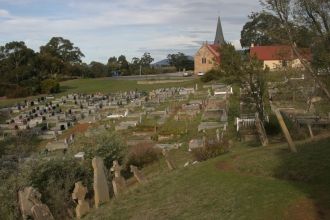
Whilhelmina was born onboard the sailing vessel Wilhelmsburg a few weeks prior to the ship arriving in Hobart Town (1855) Van Diemens land. Her name was not added to the ships passenger manifest which created a problem issuing a death certificate at Richmond Tasmania. Three year old Wilhelminia died when her health suddenly deteriorated whilst walking home from a weekly shopping trip to Richmond on a very hot summers day.
Johanna (her mother) with the help of the other children had to carry her for about 3 miles of the 5 mile trip. The doctor from Richmond was called but she died that night of suspected heat exhaustion or TB.
Wilhelmina is buried in a unmarked grave at Richmond, Tasmania. She was named after the ship she was born on.
Augusta (Kruschke) Gill was born in 1850 at Prussia to Johanna "Jane Louisa" Clocke Kruschke and Christian Kruschke, and has siblings Christopher Krushka, Fennit Kruschke, Wilhelm "William" Kruschke, Charles Matthew Kruschke, Frederick Kruschke, Wilhelmina Krushka, Miene Wilhelm Krushka, and Louisa Joanna (Krushka) Diprose. Augusta Kruschke married William Gill. Family, friend, or fan, this family history biography is for you to remember Augusta Freder Kruschke Gill.

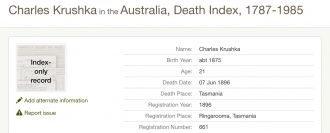
Re attached death Certificate:
Van Deimens Land have issued this certificate (birth date) based on Kushka surname issue date because of no previous family records
1875 With 1 pack horse Charles 24, Frederick 22 and Christopher 16 set out along the banks of the Dorset River prospecting. On April 22 1875 with the young Christopher leading & his two elder brothers following with the pack horse he turns right at a sharp bend in the Dorset and follows a tributary uphill with the intention of getting a better view of the surroundings from higher ground.Christopher notices a glint in quartz rock on a sharp escarpment and calls his brother. On the information gleaned from George Renison Bell they realised they have discovered quartz bearing tin. They staked it out and named it Black Boy.
1875 In October Charles, Frederick & Christopher were prospecting along the banks of a small creek east of Derby (Main Creek) which runs into the Ringarooma River in the Cascade Valley. Here they discovered and stake a mining claims on a rich load of alluvial tin which they named Brothers Home Mine etc. Realising the alluvial tin was washing from a rich vein further up the river they moved up the river and found the main lead at the junction of Brothers Creek and the Ringarooma River. Wilhelm had decided to prospect on his own and he found tin in the same area and established the Lone Brother claims. Sam Diprose is appointed Mine Manager of their numerous mines as they were established. Sam later marries Louisa Krushka with George Renison Bell as best man.
When the Krushka brothers discovered the alluvial tin they contacted their now lifelong friend George Renison Bell (Little Bell) who along with other friends stake out further claims along the creek.ouse in town (North View) and after a night of merriment departs without proclaiming it Strahan.
The discovery of tin in and around the Cascade River Valley in the 1800's by George Renison Bell, the Krushka Brothers and others leads to the rapid development of farms
& logging in the North East and the towns of Brothers Home (renamed Derby) Krushka Town (renamed Ringarooma) & Krushkas Bridge (renamed Moorina.
The original port town of Ringarooma at the mouth of the Ringarooma River was renamed Boobyalla. Mining, dredging, logging and land clearing along the length of the Ringarooma River created major siltting at it’s mouth resulting in the loss of the town and port.
Derby:
The area had been surveyed in 1855, but was not settled until 1874, Krushka brothers discovered a large lode of tin, and set up a mine (named The Brothers Mine) in the area, assuring the town's economic future. The town was originally known as Brother's Home until renamed Derby (believed to be after Edward Smith-Stanley, 14th Earl of Derby the Prime Minister of the United Kingdom).
Brother's Home Post Office opened on 1 August 1882 and was renamed Derby in 1885.
Derby reached its peak in the late 19th century, when its population reached over 3,000, and the Brothers Mine (renamed the Briseis Mine after the winner of the 1876 Melbourne Cup) was producing upwards of 120 tonnes of tin per month.
On 4 April 1929, the Briseis Dam used by the mine burst after heavy rains and the Cascade River flooded the town, killing 14 people. The mine was closed, but re-opened five years later although it never reached the same level of output as it had in the last century and closed in 1948
The Briseis Dam Disaster resulted from the bursting of a dam constructed on the Cascade River above Derby to supply water for hydraulic tin mining operations. Following unprecedented rainfall of 450 millimetres during the previous two days, on 4 April 1929 a deluge of 125 millimetres fell in one and a half hours on the catchment area above the Briseis Dam.
The resultant flood broke the dam, and a huge wall of water surged down the river valley towards the town, engulfing several houses and other buildings and pouring into the workings of the Briseis Mine. Fourteen lives were lost, including one family of five who were sitting down to a meal when their home was carried away. Senior Constable William Taylor was awarded the Royal Humane Society Medal and the King George Medal for bravery in saving eight stranded miners

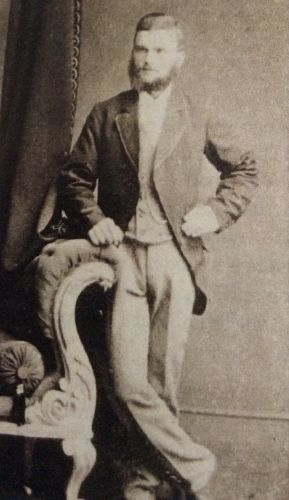
1875 With 1 pack horse Charles 24, Frederick 22 and Christopher 16 set out along the banks of the Dorset River prospecting. On April 22 1875 with the young Christopher leading & his two elder brothers following with the pack horse he turns right at a sharp bend in the Dorset and follows a tributary (Main Creek) uphill with the intention of getting a better view of the surroundings from higher ground.Christopher notices a glint in quartz rock on a sharp escarpment and calls his brother. On the information gleaned from George Renison Bell they realised they have discovered quartz bearing tin. They staked it out and named it Black Boy.
1875 The town of Bothers Home (later re-named Derby)
In April 22 1875 with the young Christopher leading & his two elder brothers following with the pack horse he turns right at a sharp bend in the Dorset and follows a tributary uphill with the intention of getting a better view of the surroundings from higher ground.Christopher notices a glint in quartz rock on a sharp escarpment and calls his brother. On the information gleaned from George Renison Bell they realised they have discovered quartz bearing tin. They staked it out and named it Black Boy.
1875 In October Charles, Frederick & Christopher were prospecting along the banks of a small creek east of Derby (Main Creek) which runs into the Ringarooma River in the Cascade Valley. Here they discovered and stake a mining claims on a rich load of alluvial tin which they named Brothers Home Mine etc. Realising the alluvial tin was washing from a rich vein further up the riiver they moved up the river and found the main lead at the junction of Brothers Creek and the Ringarooma River. Wilhelm had decided to prospect on his own and he found tin in the same area and established the Lone Brother claims. Sam Diprose is appointed Mine Manager of their numerous mines as they were established. Sam later marries Louisa Krushka with George Renison Bell as best man.
When the Krushka brothers discovered the alluvial tin they contacted their now lifelong friend George Renison Bell (Little Bell) who along with other friends stake out further claims along the creek.
1875 On the advice of George Fry (the first farmer to be granted land in Upper Ringarooma) Christopher purchases 2000 acres of land stretching from George Fry's property(Sunnyside) at Ruby Flats to south of the Dorset River. This land includes the land on which Ford View sits as his father was only squatting on the land at the time. Christopher names this large parcel of land North View and over a period of time he builds a 27 room home which includes a bakery etc. Christopher hires William Gill a friend from Richmond as farm manager. William later marries Augusta. The brothers all established horse race tracks on their properties and hold regular community race meetings, picnic days & balls.
Christopher Krushka purchased race horses and on a annual basis goes to the Melbourne Cup . He had success with his horses and in 1894 his horse (Amadeus) wins both the Hobart & Launceston Cups.
Christopher was very generous with his money and threw the Launceston Cup from a hotel balcony to the crowds in the streets below. He was later to loose his wealth when he sold his share of the mine, his generosity and the approaching WW1 and world wide depression.
Christopher established the town of Krushka Town (renamed Ringarooma) by setting up a store, hotel and donating land & building the first church. He set aside part of property & subdivides it into town blocks.
The land where the family Fairveiw homestead once stood was later taken back by the goverment of the day and a school was built on the land. Today the Ringarooma Area School stands where the Fairveiw homestead once stood.
1882 In January the Governor Sir George C Strahan in the town of Krushka with the intention of naming it Strahan. He stays in the largest house in town (North View) and after a night of merriment departs without proclaiming it Strahan.
The discovery of tin in and around the Cascade River Valley in the 1800's by George Renison Bell, the Krushka Brothers and others leads to the rapid development of farms
& logging in the North East and the towns of Brothers Home (renamed Derby) Krushka Town (renamed Ringarooma) & Krushkas Bridge (renamed Moorina.
The original port town of Ringarooma at the mouth of the Ringarooma River was renamed Boobyalla. Mining, dredging, logging and land clearing along the length of the Ringarooma River created major siltting at it’s mouth resulting in the loss of the town and port.
Derby:
The area had been surveyed in 1855, but was not settled until 1874, Krushka brothers discovered a large lode of tin, and set up a mine (named The Brothers Mine) in the area, assuring the town's economic future. The town was originally known as Brother's Home until renamed Derby (believed to be after Edward Smith-Stanley, 14th Earl of Derby the Prime Minister of the United Kingdom).
Brother's Home Post Office opened on 1 August 1882 and was renamed Derby in 1885.
Derby reached its peak in the late 19th century, when its population reached over 3,000, and the Brothers Mine (renamed the Briseis Mine after the winner of the 1876 Melbourne Cup) was producing upwards of 120 tonnes of tin per month.
On 4 April 1929, the Briseis Dam used by the mine burst after heavy rains and the Cascade River flooded the town, killing 14 people. The mine was closed, but re-opened five years later although it never reached the same level of output as it had in the last century and closed in 1948
The Briseis Dam Disaster resulted from the bursting of a dam constructed on the Cascade River above Derby to supply water for hydraulic tin mining operations. Following unprecedented rainfall of 450 millimetres during the previous two days, on 4 April 1929 a deluge of 125 millimetres fell in one and a half hours on the catchment area above the Briseis Dam.
The resultant flood broke the dam, and a huge wall of water surged down the river valley towards the town, engulfing several houses and other buildings and pouring into the workings of the Briseis Mine. Fourteen lives were lost, including one family of five who were sitting down to a meal when their home was carried away. Senior Constable William Taylor was awarded the Royal Humane Society Medal and the King George Medal for bravery in saving eight stranded miners

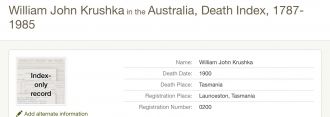
William volunteered & joined the colonial forces (Waikato Milita) fighting in the Maori wars. He joined the 2/18th Regiment, the only colonial force remaining in the country, their departure delayed by political pressure over the "peril" still facing settlers; the last soldiers finally left in February 1870.
He could have opted for a land grant in NZ but accepted a lump sum payment and returning to Van Deimens land with a pregnant Esther Trmble. He rejoined two of the three surving brothers at Mathina.
Christian, Augusta, Christopher & Louisa were already at Fordveiw, Upper Ringarooma and building a 2 room hut on the banks of the Dorset River
1875 With 1 pack horse (Three of his brothers) Charles 24, Frederick 22 and Christopher 16 set out along the banks of the Dorset River prospecting. On April 22 1875 with the young Christopher leading & his two elder brothers following with the pack horse he turns right at a sharp bend in the Dorset and follows a tributary (Main Creek) uphill with the intention of getting a better view of the surroundings from higher ground.Christopher notices a glint in quartz rock on a sharp escarpment and calls his brother. On the information gleaned from George Renison Bell they realised they have discovered quartz bearing tin. They staked it out and named it Black Boy.
1875 In October Charles, Frederick & Christopher were prospecting along the banks of a small creek (Brothers Creek) which runs into the Ringarooma River in the Cascade Valley. Here they discovered and stake a claim on a rich load of alluvial tin which they named Brothers Home Mine. Sam Diprose is appointed Mine Manager when the mine is established. Sam later marries Louisa with George Renison
Bell as best man.
Around 1875 Wilhelm who had decide to prospect on his own discovers & stakes a tin mine which he calls the Lone Brothers Mine at Derby
They quickly contacted their now lifelong friend George Renison Bell (Little Bell) who along with other friends stake out further claims along the creek.
1876 The Krushka brother cut a cart track from the mine to the original town of Ringarooma on Ringarooma Bay (Boobyalla) as it was faster & cheaper to ship the ore to Launceston from there than out of Bridport. They build a bridge across the Ringarooma River for the track and name it Krushkas Bridge (renamed Moorina)
In the same period they purchase other parcels of land near the mine & at Upper Ringarooma.
William’s Lone Brother Mine failed and was offered a share in the Brothers Home Mine which he rejected.
He later along with Sam Diprose jointly ran Brothers Home as Mine Managers as the other three brothers spent their time running the land hildings in the district.
1877 Wilhelm opens a store in the small settlement of Krushkas Bridge
Note:
1882 In January the Governor Sir George C Strahan in the town of Krushka with the intention of naming it Strahan. He stays in the largest house in town (North View) and after a night of merriment departs without proclaiming it Strahan.
The discovery of tin in and around the Cascade River Valley in the 1800's by George Renison Bell, the Krushka Brothers and others leads to the rapid development of farms & logging in the North East and the towns of Brothers Home (renamed Derby) Krushka Town (renamed Ringarooma) & Krushkas Bridge (renamed Moorina.
The original port town of Ringarooma at the mouth of the Ringarooma River was renamed Boobyalla. Mining, dredging, logging and land clearing along the length of the Ringarooma River created major siltting at it’s mouth resulting in the loss of the town and port.
Derby:
The area had been surveyed in 1855, but was not settled until 1874, Krushka brothers discovered a large lode of tin, and set up a mine (named The Brothers Mine) in the area, assuring the town's economic future. The town was originally known as Brother's Home until renamed Derby (believed to be after Edward Smith-Stanley, 14th Earl of Derby the Prime Minister of the United Kingdom).
Brother's Home Post Office opened on 1 August 1882 and was renamed Derby in 1885.
Derby reached its peak in the late 19th century, when its population reached over 3,000, and the Brothers Mine (renamed the Briseis Mine after the winner of the 1876 Melbourne Cup) was producing upwards of 120 tonnes of tin per month.
On 4 April 1929, the Briseis Dam used by the mine burst after heavy rains and the Cascade River flooded the town, killing 14 people. The mine was closed, but re-opened five years later although it never reached the same level of output as it had in the last century and closed in 1948
The Briseis Dam Disaster resulted from the bursting of a dam constructed on the Cascade River above Derby to supply water for hydraulic tin mining operations. Following unprecedented rainfall of 450 millimetres during the previous two days, on 4 April 1929 a deluge of 125 millimetres fell in one and a half hours on the catchment area above the Briseis Dam.
The resultant flood broke the dam, and a huge wall of water surged down the river valley towards the town, engulfing several houses and other buildings and pouring into the workings of the Briseis Mine. Fourteen lives were lost, including one family of five who were sitting down to a meal when their home was carried away. Senior Constable William Taylor was awarded the Royal Humane Society Medal and the King George Medal for bravery in saving eight stranded miners

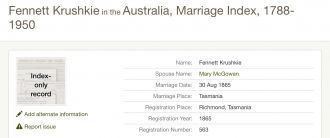
At the age of 18 Fennit leaves home and moves to Hobart Town where he obtains a job with a Chandler delivering goods around Hobart.
It is there that he meets and marries Mary Gowan, the daughter of a wealthy shipping family.
A daughter is born but when Fennit dies of TB Mary and the daughter dissapear and the family refuse to tell Christian where they are. Because of their upbringing the Gowans did not want the Krusckes to have contact with Mary or the baby. All contactact was lost.
Did Mary marry again and what happened to the baby girl ?

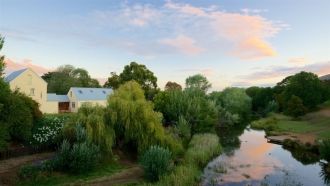
Johanna was born in the town of Kay near the Oder River, Prussia. She was working as a dairy maid when she met Christian.
Johanna, Christian & the children lived in a little workers cottage at the farm of Laburnum Park on the banks of the Coal River 5 miles north of Richmond, Tasmania.
Laburnum Park house and farm still exists today.
In 1862 whilst home alone with the childre Johanna was sitting in a chair with baby Lousia on the floor in front of her when she starting coughing blood and collapsed. One of the boys ran to get Christian but she had died.
Johanna (Jane Louisa) is buried in an unmarked grave at Richmond, Tasmania
Augustine Hess was born in 1814 to Anna Louisa (Grand) Ry and Christian Kruschke, and has siblings Christian Kruschke, Louisa Kruschke, and Ferdinand Kruschke. Family, friend, or fan, this family history biography is for you to remember Augustine Kruschke Hess.

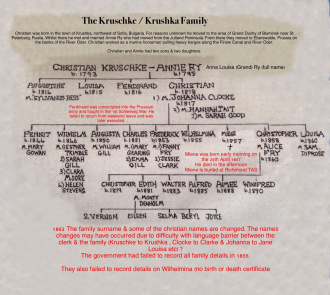
Christian was born in the town of Krushka, northwest of Sofia, Bulgaria. For reasons unknown he moved to the area of Grand Duchy of Bluminsk near St Peterburg, Rusiia. Whilst there he met and married Annie Ry who had moved from the Jutland Peninsula.
From there they moved to Eberswalde, Prussia on the banks of the River Oder. Christian worked as a marine horseman pulling heavy barges along the Finow Canal and River Oder.
Christian and Annie had two sons & two daughters.
Annie was born in Jutland, Denmark and her full name on their wedding certificate was recorded as Anna Louisa (Grand) Ry but she preferred to be called Annie Ry
For reasons unknown she move to the area of Grand Duchy of Bluminsk near St Peterburg, Rusiia. Whilst there she met and married Christian who had moved up from Kushka, Bulgaria
From there they moved to Eberswalde, Prussia on the banks of the River Oder where Christian worked as a marine horseman pulling heavy barges along the Finow Canal and River Oder.

